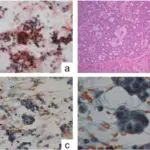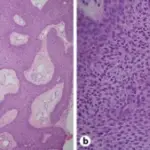Cylindroma is also known as the turban tumor. It is a tumor arising from the apocrine sweat gland of the skin and is benign.
What is the Pathology of Cylindroma?
The pathology of cylindroma is the study of the disease that affects the apocrine sweat glands found in the human skin.
-Etiology: The cause of cylindroma is lack of the CYLD gene.
-Genes involved: MYB-NFIB, CYLD genes.
-Pathogenesis: The sequence of events that lead to cylindroma; cellular cause of cylindromas is unknown.
-Morphology: The morphology associated with cylindroma shows around like shape hence the name cylindroma, pink in color.
-Histology: The histology associated with cylindroma shows ductal cells with large pale nuclei and also undifferentiated peripheral epithelial cells with small dark nuclei, hyaline droplets, and tumor lobule nests.
How does Cylindroma Present?
Patients with cylindroma typically are more common in females than in males and affect the middle-aged and the elderly persons and can increase in number as one grows older. The symptoms, features, and clinical findings associated with cylindroma include slow-growing, painful and may be multiple or single.
How is Cylindroma Diagnosed?
The cylindroma is diagnosed by physical examination, use of a dermatoscope, skin biopsy, and genetic test to test the mutation of the CYLD gene.
How is Cylindroma Treated?
The cylindroma is treated by signal inhibition to the CYLD gene, surgical excision, curettage and cryotherapy, and electrodesiccation.
What is the Prognosis of Cylindroma?
The prognosis of cylindroma is good if it is not cancerous but if it is the prognosis is poor.



